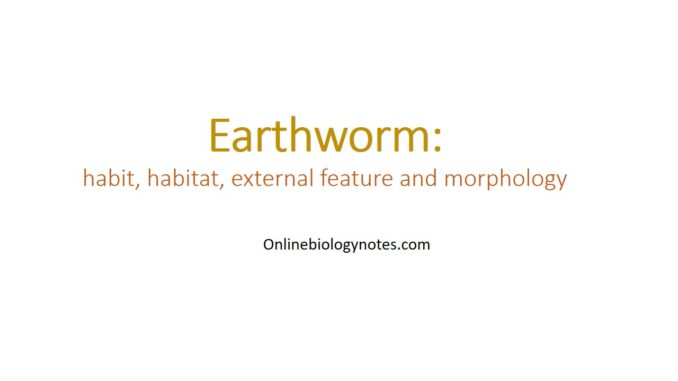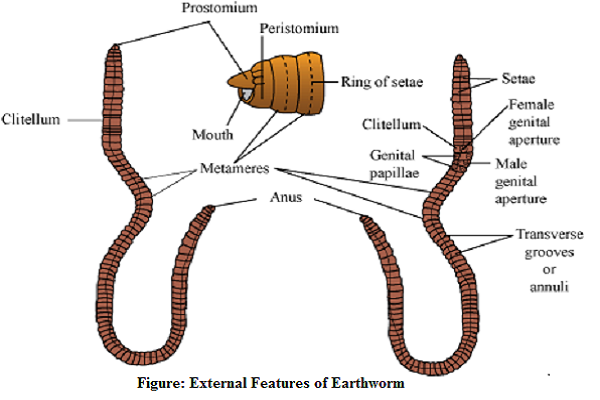
Introduction to Earthworm (Pheretima posthuma):
- Scientific Classification of Earthworm:
- Kingdom: Animalia
- Phylum: Annelida
- Class: Oligochaeta
- Order: Opisthopora
- Genus: Pheretima
- Species: posthuma
Habit and habitat of Earthworm:
- Earthworms are segmented invertebrates, that are reddish brown in color.
- Being terrestrial in nature, it mostly inhabits the upper layer of the moist soil.
- It is also fossorial in nature, i.e. it burrows the soil and lives inside burrows made in moist soil.
- They feed on organic matter present in the soil and the undigested substances are expelled in the form of castings.
- The holes of earthworm can be recognized by the presence of castings termed as pellets.
- Earthworms are generally known as farmer’s friend as the fecal deposits of earthworm helps to increase the fertility of soil and burrowing aids in adequate aeration of the soil.
- They are distributed globally and are ranged from sea level to altitude of 3000m.
- However, it is more abundant during the rainy season.
- The earthworm is nocturnal in nature, meaning it stays active at night.
External morphology of Earthworm
- Mouth:
- It is crescentic in shape and lies on the ventral side of a first segment i.e. peristomium.
- Dorsal to it, prostomium is present.
- Anus:
- It is present on the anal segment, i.e. the last segment.
- The anal segment lies in the vertical slit like aperture.
- Its size is small.
- Male genital pore:
- The male genital pores lie ventrolaterally on 18th segment.
- They are a pair of crescentic apertures.
- The male reproductive bodies get discharged through these pores.
- Female genital pore:
- A single, minute female genital pore is present in the 14th segment mid-ventrally.
- The female reproductive bodies are discharged through it.
- Dorsal pores:
- They are present after 12 segments except the last segment.
- Coelomic fluid oozes out from this pore that lubricates the surface of body.
- Nephridiopores:
- They are present in all segments except first two segments.
- In a body wall, several minute nephridiopores are present.
- The apertures of integumentary nephridia represent the nephridiopores.
- The metabolic wastes are discharged out of the body through these pores.
- Spermathecal pores:
- They are situated ventrolaterally.
- They are through intersegmental in nature found in segment 5/6, 6/7, 7/8, 8/9.
- The spermatozoa enter the spermatheca through these pores.
- During copulation, these pores store sperm.
- Genital papillae:
- The genital papillae are the most prominent structures present in the ventral side of the body of earthworm.
- It is a conical elevation found in segment 17 and 19 a pair each.
- These papillae aids in temporary attachment in course of reproduction.

Morphological feature of Earthworm:
i. Shape and size:
- The body of earthworm is long and cylindrical almost pointed at both the anterior and posterior end.
- It shows bilateral symmetry.
- The anterior end is tapering and the posterior end is more or less blunt.
- The length of earthworm is about 15cm and the width varies from 3-5mm.
ii. Coloration:
- The body appears reddish brown in color.
- The dorsal region is darker in comparison to other regions, and has median dark line.
- The dark coloration is because of the deposition of porphyrin pigment.
- The dorsal blood vessel forms the median dark line.
iii. Segmentation:
- The body is metamerically segmented, seen with 100-120 similar segments called metameres.
- Both the external and internal segmentation is present.
- The circular groove called annuli forms the external segmentation.
- The muscular partition termed as septa forms the internal segmentation.
- The body can be divided into dorsal, ventral, anterior and posterior regions.
- The anterior region lies in close proximity to the clitellum whereas the posterior region lies far from the clitellum.
- In the anterior end, the mouth and the prostomium is present.
- The prostomium is a lobe that aids as a covering for the mouth and helps in burrowing by its wedge like structure.
- Prostomium functions as sensory part.
- The first body segment is termed as the peristomium that possess the mouth.
iv. Setae:
- Setae are S-shaped chitinous structures and are yellow in color.
- Their number ranges from 80-120 per segment.
- Setae are responsible for locomotion and are present in all segments except the first, last and clitellar segments.
- It is arranged in perichaetine order, i.e. in a ring/circle.
- In the setal sac of the body wall, setae are embedded.
- The setae are operated by 2 sets of muscles:
- A pair of protractor muscles (contraction results in extension of sac)
- Single retractor muscle (contraction results in withdrawal of setae)
- Ventral setae are used for crawling on the ground and lateral setae are used while moving in burrows.
v. Clitellum:
- The clitellum is thick girdle like structure formed by body wall.
- It is glandular in nature and pinkish in color.
- It is present in 14th, 15th, and 16th segments.
- It secretes mucus, albumen and during breeding season, it secretes cocoon.
- On the basis of position of clitellum, the body can be divided into three regions that are:
- Preclitellar region (1-13)
- Clitellar region (14, 15 and 16)
- Postclitellar region (17-last)
vi. Body wall:
- The body wall when divided from the surface inwards, comprises of cuticle, epidermis, muscular layers and coelomic epithelium.
- Cuticle:
- It is thin and elastic in nature.
- It is non-cellular and is double layered.
- It is a protective membrane composed of collagen fibers and polysaccharide secreted by the underlying epidermis.
- It consists of several pores through which the epidermal glands open outside.
- Epidermis:
- It is cellular in nature.
- It is a single layer that possess 4 different types of cells lying on basement membrane.
- Supporting Cells: It forms main bulk of epidermis (provides nutrition to embryo).
- Gland cells has two types: Mucus cells (mucus secreting cells) and albumen cells (secret albumin abundant in clitellum)
- Basal Cells: They are found at inner sides of glands and supporting cells (also called replacing cells).
- Receptor Cells
- Dermis or Muscular layer:
- It lies just below the epidermis.
- It has two types of muscles: circular muscles and longitudinal muscles.
- Circular Muscles:
- It is an outer thin layer of muscles found in whole body wall.
- Pigment cells, connective tissue, nerve fibres and blood capillaries are found scattered in them.
- The length of the earthworm increases by the contraction of these muscles while the thickness decreases.
- Longitudinal muscles:
- It is the thick layer of muscle fibres present beneath the circular muscle layer.
- It occurs in the form of bundles in the body wall.
- The earthworm shortens in length by the contraction of these muscles but increases in thickness.
- Coelomic epithelium:
- It is the innermost layer of the body wall.
- It is known as somatic peritoneum or parietal layer.
- It is single-celled layer with small nuclei in each cell.
vii. Septum
- In Pheretima posthuma, septa are present in all segments except first four segments and 9/10 segments.
- The first Septum lies between 4/5 and is thin, membranous and oblique.
- The next four septa are thick, muscular and obliquely placed between 5/6, 6/7, 7/8 and 8/9.
- The first nine septa (4/5,5/6, 6/7, 7/8, 8/9, 10/11, 11/12, 12/13, and 13/14) are complete i.e. they do not have any apertures.
- The remaining septa (14/15, 15/16, 17/18, and so on upto the posterior end) are incomplete i.e. they have perforations.
viii. Coelom
- The body cavity is true and schizocoelous, i.e., formed by the splitting of mesodermal band and strip.
- Dorsal pore of earthworm links externally with the coelom.
- The intersegmental septa divide the coelom of earthworm into compartments.
- The coelomic fluid of earthworm is alkaline and colorless fluid.
- It contains following 4 types of coelomic corpuscles besides water, salt and proteins.
- Amoebocytes/ phagocytes/granulocytes/ eleocytes:
- These are small, numerous in number, spheroidal in shape, with a number of petal-like pseudopodia and a large nucleus.
- These are also termed as Phagocytes (engulfing excretory wastes) as they consist engulfing foreign materials like bacteria in cytoplasm.
- Because of large spherical structure, concavity & a small nucleus and with many food granules and fat droplets, amoebocytes are also called Granulocytes.
- These are probably nutritive in function.
- Mucocytes:
- These are elongated cells with fan like process.
- These are amoebocytes, that are modified to become elongated and vase-like with nucleus at narrow end and the other end expanded like a fan (fan shaped)
- Circular nucleated cells (leucocytes):
- These are small, flat, circular, with a large nucleus and clear cytoplasm.
- These are lesser in number (10%approx).
- Chloragogen cells/Chlorocyte cells/eleocytes/yellow cells:
- Chloragogen cells are small, star-shaped with small nucleus.
- These cells are analogous to liver of vertebrates.
- These are both nutritive and excretory in function.
- It is concerned with storage of reserve food and deamination of proteins and formation of urea.
- Coelomic fluid in Pheretima posthuma plays role as a hydraulic skeleton thus supporting in locomotion.
- Hemoglobin is absent.
- The coelomic fluid is secreted by partial peritoneum continuously produced and lost.
- When earthworm is dipped in spirit, a white milky fluid called coelomic fluid is ejected through the dorsal pores.
- The lymph glands secrete amoebocytes and blood corpuscles in Pheretima.
Summary Points on Earthworm morphology
- Earthworm belongs to class Oligochaeta.
- Peristomium is the first segment of earthworm.
- Clitellum is located in 14th, 15th, and 16th segments.
- 2 pairs of genital papillae are found in 17th and 19th segment.
- Spermathecal pores lie in 5/6, 6/7, 7/8, 8/9 segments.
- Earthworm is hermaphrodite in nature.
- Porphyrin is skin pigment that gives dark coloration.
- The body cavity of earthworm is schizocoel.
- Sperms are stored in spermathecal pores during copulation.
